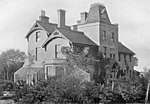Globe Pit
Geological Conservation Review sitesSites of Special Scientific Interest in EssexThurrock

Globe Pit is a 0.4-hectare (0.99-acre) geological Site of Special Scientific Interest in Little Thurrock in Essex. It is a Geological Conservation Review site.Natural England describes Globe Pit as "an important site for the interrelationship of archaeology with geology since it is vital in the correlation of the Lower Palaeolithic chronology with the Pleistocene Thames Terrace sequence". Interpretation of the site is controversial, and it is therefore important for future research. There is a considerable quantity of Clactonian flint tools, dated by Paul Pettit and Mark White to MIS 10 to 9, around 350,000 years ago. The site is on private land with no public access.
Excerpt from the Wikipedia article Globe Pit (License: CC BY-SA 3.0, Authors, Images).Globe Pit
Gunning Road, Thurrock
Geographical coordinates (GPS) Address Nearby Places Show on map
Geographical coordinates (GPS)
| Latitude | Longitude |
|---|---|
| N 51.479 ° | E 0.339 ° |
Address
Gunning Road
Gunning Road
RM17 6UQ Thurrock
England, United Kingdom
Open on Google Maps








